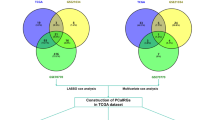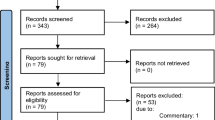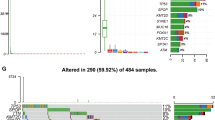Abstract
Background
Over the past few decades, immunological checkpoint therapy has been an increasingly prominent strategy in the treatment of tumors, including prostate cancer (PC). There are few systematic studies of the phenotypic of tumor-infiltrating immune cells in PC tissues.
Methods
CIBERSORT is an analytical tool for estimating the abundance of member cell types in mixed cell population by gene expression data. Herein, we analyzed different levels of tumor-infiltrating immunity cells in normal tissue compared with PC using CIBERSORT.
Results
The results showed that proportion of M1 macrophages and resting mast cells presented significant differences in prostate tumor than these normal tissues. A higher proportion of resting mast cells was associated with a worse outcome and M1 macrophages was associated with a favorable outcome. Moreover, the radiotherapy and targeted molecular therapy can affect the immune infiltration of M1 macrophages and resting mast cells.
Conclusions
Resting mast cells and M1 macrophages has an important role in the prognosis of prostate cancer. Our data provides valuable information about the future treatment of PC.





Similar content being viewed by others
References
Punnen S, Cooperberg MR. The epidemiology of high-risk prostate cancer. Curr Opin Urol. 2013;23(4):331–6. https://doi.org/10.1097/MOU.0b013e328361d48e.
Lu X, Horner JW, Paul E, Shang X, Troncoso P, Deng P, et al. Effective combinatorial immunotherapy for castration-resistant prostate cancer. Nature. 2017;543(7647):728–32. https://doi.org/10.1038/nature21676.
Wilt TJ, Brawer MK, Jones KM, Barry MJ, Aronson WJ, Fox S, et al. Radical prostatectomy versus observation for localized prostate cancer. N Engl J Med. 2012;367(3):203–13. https://doi.org/10.1056/NEJMoa1113162.
Siegel R, Naishadham D, Jemal A. Cancer statistics, 2012. CA Cancer J Clin. 2012;62(1):10–29. https://doi.org/10.3322/caac.20138.
Schepisi G, Farolfi A, Conteduca V, Martignano F, De Lisi D, Ravaglia G, et al. Immunotherapy for prostate cancer: where we are headed. Int J Mol Sci. 2017. https://doi.org/10.3390/ijms18122627.
Horwich A, Hugosson J, de Reijke T, Wiegel T, Fizazi K, Kataja V, et al. Prostate cancer: ESMO consensus conference guidelines 2012. Ann Oncol. 2013;24(5):1141–62. https://doi.org/10.1093/annonc/mds624.
Chippaux C, Anraedt JL. Anterior pituitary endocrine therapy in osteoporosis and delays of consolidation. Med Trop (Mars). 1960;20:589–98.
Shankaran V, Ikeda H, Bruce AT, White JM, Swanson PE, Old LJ, et al. IFNgamma and lymphocytes prevent primary tumour development and shape tumour immunogenicity. Nature. 2001;410(6832):1107–11. https://doi.org/10.1038/35074122.
Gnjatic S, Bronte V, Brunet LR, Butler MO, Disis ML, Galon J, et al. Identifying baseline immune-related biomarkers to predict clinical outcome of immunotherapy. J Immunother Cancer. 2017;5:44. https://doi.org/10.1186/s40425-017-0243-4.
Ribas A, Shin DS, Zaretsky J, Frederiksen J, Cornish A, Avramis E, et al. PD-1 blockade expands intratumoral memory T cells. Cancer Immunol Res. 2016;4(3):194–203. https://doi.org/10.1158/2326-6066.CIR-15-0210.
Chen B, Khodadoust MS, Liu CL, Newman AM, Alizadeh AA. Profiling tumor infiltrating immune cells with CIBERSORT. Methods Mol Biol. 2018;1711:243–59. https://doi.org/10.1007/978-1-4939-7493-1_12.
Newman AM, Liu CL, Green MR, Gentles AJ, Feng W, Xu Y, et al. Robust enumeration of cell subsets from tissue expression profiles. Nat Methods. 2015;12(5):453–7. https://doi.org/10.1038/nmeth.3337.
Ali HR, Chlon L, Pharoah PD, Markowetz F, Caldas C. Patterns of immune infiltration in breast cancer and their clinical implications: a gene-expression-based retrospective study. PLoS Med. 2016;13(12):e1002194. https://doi.org/10.1371/journal.pmed.1002194.
Nera KP, Kylaniemi MK, Lassila O. Regulation of B cell to plasma cell transition within the follicular B cell response. Scand J Immunol. 2015;82(3):225–34. https://doi.org/10.1111/sji.12336.
Lang ML. How do natural killer T cells help B cells? Expert Rev Vaccines. 2009;8(8):1109–21. https://doi.org/10.1586/erv.09.56.
Ettinger R, Sims GP, Fairhurst AM, Robbins R, da Silva YS, Spolski R, et al. IL-21 induces differentiation of human naive and memory B cells into antibody-secreting plasma cells. J Immunol. 2005;175(12):7867–79. https://doi.org/10.4049/jimmunol.175.12.7867.
Komohara Y, Fujiwara Y, Ohnishi K, Takeya M. Tumor-associated macrophages: potential therapeutic targets for anti-cancer therapy. Adv Drug Deliv Rev. 2016;99(Pt B):180–5. https://doi.org/10.1016/j.addr.2015.11.009.
Oleinika K, Nibbs RJ, Graham GJ, Fraser AR. Suppression, subversion and escape: the role of regulatory T cells in cancer progression. Clin Exp Immunol. 2013;171(1):36–45. https://doi.org/10.1111/j.1365-2249.2012.04657.x.
Sakaguchi S, Ono M, Setoguchi R, Yagi H, Hori S, Fehervari Z, et al. Foxp3+ CD25+ CD4+ natural regulatory T cells in dominant self-tolerance and autoimmune disease. Immunol Rev. 2006;212:8–27. https://doi.org/10.1111/j.0105-2896.2006.00427.x.
Curiel TJ. Tregs and rethinking cancer immunotherapy. J Clin Investig. 2007;117(5):1167–74. https://doi.org/10.1172/JCI31202.
Mosser DM, Edwards JP. Exploring the full spectrum of macrophage activation. Nat Rev Immunol. 2008;8(12):958–69. https://doi.org/10.1038/nri2448.
Chavez-Galan L, Olleros ML, Vesin D, Garcia I. Much more than M1 and M2 macrophages, there are also CD169(+) and TCR(+) macrophages. Front Immunol. 2015;6:263. https://doi.org/10.3389/fimmu.2015.00263.
Palmieri EM, Menga A, Martin-Perez R, Quinto A, Riera-Domingo C, De Tullio G, et al. Pharmacologic or genetic targeting of glutamine synthetase skews macrophages toward an M1-like phenotype and inhibits tumor metastasis. Cell Rep. 2017;20(7):1654–66. https://doi.org/10.1016/j.celrep.2017.07.054.
Mazalova L, Sladek Z, Raudenska M, Balvan J, Gumulec J, Masarik M. Effect of prostate cancer cell line supernatant on functional polarization in macrophages. Bratisl Lek Listy. 2018;119(8):516–21. https://doi.org/10.4149/BLL_2018_095.
Ridge SM, Bhattacharyya D, Dervan E, Naicker SD, Burke AJ, Murphy JM, et al. Secreted factors from metastatic prostate cancer cells stimulate mesenchymal stem cell transition to a pro-tumourigenic ‘activated’ state that enhances prostate cancer cell migration. Int J Cancer. 2018;142(10):2056–67. https://doi.org/10.1002/ijc.31226.
Mantovani A, Allavena P. The interaction of anticancer therapies with tumor-associated macrophages. J Exp Med. 2015;212(4):435–45. https://doi.org/10.1084/jem.20150295.
Hanoteau A, Newton JM, Krupar R, Huang C, Liu HC, Gaspero A, et al. Tumor microenvironment modulation enhances immunologic benefit of chemoradiotherapy. J Immunother Cancer. 2019;7(1):10. https://doi.org/10.1186/s40425-018-0485-9.
Banchereau J, Briere F, Caux C, Davoust J, Lebecque S, Liu YJ, et al. Immunobiology of dendritic cells. Annu Rev Immunol. 2000;18:767–811. https://doi.org/10.1146/annurev.immunol.18.1.767.
Steinman RM, Banchereau J. Taking dendritic cells into medicine. Nature. 2007;449(7161):419–26. https://doi.org/10.1038/nature06175.
Mohammadzadeh M, Shirmohammadi M, Ghojazadeh M, Nikniaz L, Raeisi M, Aghdas SAM. Dendritic cells pulsed with prostate-specific membrane antigen in metastatic castration-resistant prostate cancer patients: a systematic review and meta-analysis. Prostate Int. 2018;6(4):119–25. https://doi.org/10.1016/j.prnil.2018.04.001.
Stoitzner P, Green LK, Jung JY, Price KM, Atarea H, Kivell B, et al. Inefficient presentation of tumor-derived antigen by tumor-infiltrating dendritic cells. Cancer Immunol Immunother. 2008;57(11):1665–73. https://doi.org/10.1007/s00262-008-0487-4.
Metcalfe DD, Baram D, Mekori YA. Mast cells. Physiol Rev. 1997;77(4):1033–79. https://doi.org/10.1152/physrev.1997.77.4.1033.
Burtin C, Ponvert C, Fray A, Scheinmann P, Lespinats G, Loridon B, et al. Inverse correlation between tumor incidence and tissue histamine levels in W/WV, WV/+, and +/+ mice. J Natl Cancer Inst. 1985;74(3):671–4.
Benyon RC, Bissonnette EY, Befus AD. Tumor necrosis factor-alpha dependent cytotoxicity of human skin mast cells is enhanced by anti-IgE antibodies. J Immunol. 1991;147(7):2253–8.
Singer J, Jensen-Jarolim E. IgE-based immunotherapy of cancer—a comparative oncology approach. J Carcinog Mutagen. 2014;5(3):1000176. https://doi.org/10.4172/2157-2518.1000176.
Nakai Y, Nelson WG, De Marzo AM. The dietary charred meat carcinogen 2-amino-1-methyl-6-phenylimidazo[4,5-b]pyridine acts as both a tumor initiator and promoter in the rat ventral prostate. Cancer Res. 2007;67(3):1378–84. https://doi.org/10.1158/0008-5472.CAN-06-1336.
Johansson A, Rudolfsson S, Hammarsten P, Halin S, Pietras K, Jones J, et al. Mast cells are novel independent prognostic markers in prostate cancer and represent a target for therapy. Am J Pathol. 2010;177(2):1031–41. https://doi.org/10.2353/ajpath.2010.100070.
Acknowledgements
This work was supported by the Cuiying Scientific and Technological Innovation Program of Lanzhou University Second Hospital (Grant no. CY2018-QN13).
Author information
Authors and Affiliations
Corresponding author
Ethics declarations
Conflict of interest
The authors declare that there are no conflicts of interest.
Ethical approval
This article does not contain any studies with human participants or animals performed by the author.
Informed consent
As this study is based on a publicly available database without identifying patient information, informed consent was not needed.
Additional information
Publisher's Note
Springer Nature remains neutral with regard to jurisdictional claims in published maps and institutional affiliations.
Rights and permissions
About this article
Cite this article
Zhang, E., Dai, F., Mao, Y. et al. Differences of the immune cell landscape between normal and tumor tissue in human prostate. Clin Transl Oncol 22, 344–350 (2020). https://doi.org/10.1007/s12094-019-02128-5
Received:
Accepted:
Published:
Issue Date:
DOI: https://doi.org/10.1007/s12094-019-02128-5




